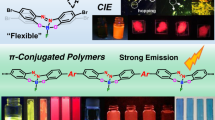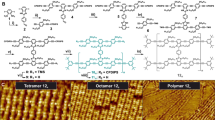Abstract
ONE advantage of using conjugated polymers in semiconductor applications is that they can be processed using techniques well established for conventional polymers. We reported recently that poly(p-phenylenevinylene) could be used as the active layer in a light-emitting diode1, producing yellow/green emission. We have now found that related copolymers, comprising a combination of different arylene units, can be chemically tuned to provide a range of materials with considerably improved properties for this and other applications. By incorporating two different leaving groups into a precursor copolymer, we can selectively eliminate one of these, to give a conjugated/non-conjugated copolymer, or both, to give a fully conjugated copolymer. This allows us to induce local variations in the Π-Π* electronic energy gap at both the molecular and supramolecular level. Variations at the molecular level can act to trap excitons, hindering their migration to quenching sites, and we find that these materials give strongly enhanced quantum yields for electroluminescence (by a factor of up to 30). They also allow control of the colour of emission. Variations at the supramolecular level, by patterning the films to control the progress of conversion, allow the production of structures suitable for multicolour displays. The ability to pattern the film also allows for fabrication of optical waveguides, as regions with different energy gaps have different refractive indices.
This is a preview of subscription content, access via your institution
Access options
Subscribe to this journal
Receive 51 print issues and online access
$199.00 per year
only $3.90 per issue
Buy this article
- Purchase on Springer Link
- Instant access to full article PDF
Prices may be subject to local taxes which are calculated during checkout
Similar content being viewed by others
References
Burroughes, J. H. et al. Nature 347, 539–541 (1990).
Wessling, R. A. J. Polym. Sci., Polym. Symp. 72, 55–56 (1985).
Lahti, P. M., Modarelli, D. A., Denton, F. R., Lenz, R. W. & Karasz, F. E. J. Am. chem. Soc. 110, 7258–7259 (1988).
Lenz, R. W., Han, C.-C. & Lux, M. Polymer 30, 1041–1047 (1989).
Tokito, S., Momii, T., Murata, H., Tsutsui, T. & Saito, S. Polymer 31, 1137–1141 (1990).
Ohnishi, T., Noguchi, T., Nikano, T., Hirooka, M. & Murase, I. Synth. Metals 41–43, 309–312 (1991).
Han, C.-C. & Elsenbaumer, R. L. Synth. Metals 41–43, 849–854 (1991).
Askari, S. H., Rughooputh, S. D. & Wudl, F. Synth. Metals 29, E129–134 (1989).
Burn, P. L., Bradley, D. D. C., Brown, A. R., Friend, R. H. & Holmes, A. B. Synth. Metals 41–43, 261–264 (1991).
Swatos, W. J. & Gordon, B. Polym. Prep. (Am. Chem. Soc. Div. Polym. Chem) 31(1), 505–506 (1990).
Burn, P. L. et al. J. chem. Soc., Chem. Commun. 32–34 (1992).
Braun, D. & Heeger, A. J. Appl. Phys. Lett. 58, 1982–1984 (1991).
Bradley, D. D. C. Chem. Brit. 27, 719–723 (1991).
Wong, K. S. et al. J. Phys. C. (Solid State Phys.) 20, L187–L194 (1987).
Bradley, D. D. C. & Friend, R. H. J. Phys. condensed Matter 1, 3671–3678 (1989).
Ziemelis, K. E. et al. Phys. Rev. Lett. 66, 2231–2234 (1991).
Halliday, D. A., Bradley, D. D. C., Burn, P. L., Friend, R. H. & Holmes, A. B. Synth. Metals 41–43, 931–934 (1991).
Bradley, D. D. C. et al. Springer Series on Solid States Sciences 99, Electronic Properties of Conjugated Polymers IV (ed. Kuzmany, H.) (Springer, Berlin, in the press).
Author information
Authors and Affiliations
Rights and permissions
About this article
Cite this article
Burn, P., Holmes, A., Kraft, A. et al. Chemical tuning of electroluminescent copolymers to improve emission efficiencies and allow patterning. Nature 356, 47–49 (1992). https://doi.org/10.1038/356047a0
Received:
Accepted:
Issue Date:
DOI: https://doi.org/10.1038/356047a0
Comments
By submitting a comment you agree to abide by our Terms and Community Guidelines. If you find something abusive or that does not comply with our terms or guidelines please flag it as inappropriate.



